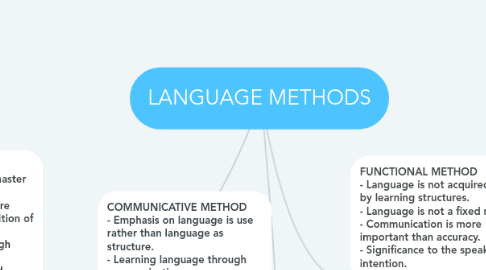
1. STRUCTURAL METHOD - Students are taught to master the pattern of sentences. - Structures’ domain is more important than the acquisition of vocabulary. - Language is learnt through repetition. - Speech is mainly stressed although reading and writing are also developed.
1.1. GRAMMAR TRANSLATION METHOD - Use of translation and grammar study as the main teaching techniques. - Use of the mother tongue rather than the target language. - Vocabulary taught through lists of isolated words. - Detailed grammar rules explanation.
1.1.1. ADVANTAGES - Easy to carry out. - It does not require teachers to speak a good English. - Texts books as only tool. DISADVANTAGES - Students’ lack of comprehension due to the significance placed on translation. - It does not allow students to create meaning in English. - Extensive memorization and little interaction.
1.2. AUDIOLINGUAL METHOD - Emphasis on teaching listening and speaking skills. - Use of dialogues to present the language. - Use of certain practice techniques such as mimicry, memorization and pattern drills. - Main use of the target language.
1.2.1. ADVANTAGES - Separation of the language skills. - Emphasis on sentences production, control over grammatical structures and development of oral ability. - Developing simple technique and making use of language lab. DIS ADVANTAGES - Lack of the development of language competence and effectiveness. - Learners having little control over their learning. - Teachers' domination of the class.
1.3. TPR METHOD - Combination of both speech and action. - Learners play an active role and evaluate their own progress. - Grammar is inductively taught. - Learning language by body movements and gestures.
1.3.1. AD VANTAGES - Encourage students’ achievement of fluency and positive thinking. - It is fun, easy to prepare and memorable. - It facilitates students with meaning in real context. DI SADVANTAGES - It may be challenge for shy students. - It is limited since not everything can be developed through this method. - It does not give students the opportunity to express their own thoughts and may be bored when overusing it.
2. FUNCTIONAL METHOD - Language is not acquired only by learning structures. - Language is not a fixed reality. - Communication is more important than accuracy. - Significance to the speaker intention.
2.1. NATURAL APPROACH - The aim is to foster the communicative competence, not grammatical perfection. - Emphasis on listening. - Speech acquisition through listening. - Limited use of the mother tongue.
2.1.1. AD VANTAGES - It is very simple to carry out. - It is reliable as it is widely used. - There is no grammar instruction in this method. DISADVANTAGES - It takes long time and learners can do only elementary things. - It does not suit for those who do not have much time. - The method rarely concerns about correctness.
2.2. DIRECT METHOD - Lessons are in the target language. - Focus on everyday vocabulary and visual aids. - Accuracy on pronunciation and grammar. - Emphasis on comprehension and oral expression.
2.2.1. ADVANTAGES - Teach the language itself and not about the language. - Language is taught the same way the mother tongue is acquired. - Only the target language is used and learning is contextualized. - t is focused on speech what leads to real communication. DISADVANTAGES - It does not fulfill the needs of educational system. - L1 has not previous language learning experience but learning L2 does. - Effective only used by native speakers.
